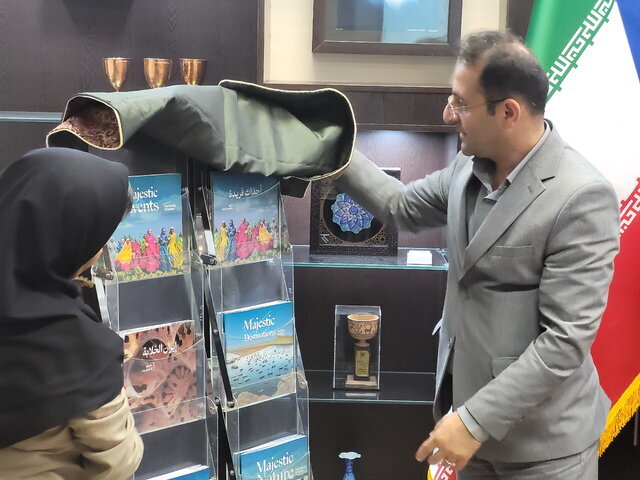Tourism ministry reveals special content aimed to boost arrivals

TEHRAN – On Wednesday, the Ministry of Cultural Heritage, Tourism, and Handicrafts held a ceremony to unveil innovative tourism content aimed at attracting more foreign visitors.
Speaking at the event, Moslem Shojaei, who presides over the office for Foreign Tourism Marketing and Development, provided detailed insights into the ministry’s latest offerings and answered questions asked by the attendees.
The first product unveiled was a multimedia tourism booklet, comprising nine booklets and 108 PDF files in 13 foreign languages, all available in various formats.
“This content will be accessible offline and distributed to cultural attachés, embassies in Iran, Iranian embassies abroad, and tourism professionals to be disseminated in target markets,” Shojaei said.
“This new content covers a wide range of tourist attractions along with various images from across the country’s geographical landscape,” Shojaei noted.
The official highlighted that these new collections represent a significant advancement from the traditional books and brochures previously produced by the ministry.
Arash Nouraghaei, a well-known tourism expert who played a crucial role in developing these materials, explained the meticulous process of categorizing the images and texts to achieve the desired result.
Nouraghaei also addressed the long-standing tourism brand “Majestic Iran,” promoted by the Ministry of Cultural Heritage. He lamented that this brand has not gained significant visibility and is rarely seen. “Compared to other countries that even display their tourism brands on paper tablecloths, we have a lot of work to do to highlight our brand,” Nouraghaei stated.
Elsewhere in his remarks, Shojaei announced the second tourism content product: a motion graphic package introducing Iran, which will be sent to 28 countries with which Iran has established visa-free agreements.
“Following Iran’s unilateral visa waiver with 28 countries, we compared data from March and April 2023 with the same period last year, revealing a 20% increase in tourist arrivals,” Shojaei reported.
He added that the visa waiver has prompted some countries to reciprocate, resulting in mutual visa-free arrangements, as seen with Oman and recently Tunisia.
The Islamic Republic expects to reap a bonanza from its numerous tourist spots such as bazaars, museums, mosques, bridges, bathhouses, madrasas, mausoleums, churches, towers, and mansions, of which 27 are inscribed on the UNESCO World Heritage list.Shojaei also mentioned another marketing initiative. “We found a more effective approach to roadshows, where Iranian and foreign private sectors meet and negotiate.”
The official elaborated on the success of roadshows in Oman and China, which included government and private sector delegations. Future roadshows are planned for Malaysia, Indonesia, Vietnam, and India, with preparations underway for Turkey and Russia, he added.
“Typically, tourism agencies involved in attracting tourists to Iran participate in these roadshows, meeting with agencies in target countries focused on outbound travel,” Shojaei underlined.
Last year, the ministry produced 25,000 gigabytes of [multimedia] content distributed to various countries, with 7,400 gigabytes of diverse content shared at different tourism events or provided to various delegations.
In conclusion, Shojaei reminded the ministry’s commitment to more accurately showcase Iran’s attractions on a global scale.
Earlier in April, the tourism minister, Ezzatollah Zarghami said that the Islamic Republic had granted visa-free access to approximately half of the world’s population, “totaling around four billion people.”
“Currently, half of the world’s population can travel to Iran without visas,” Zarghami said.
Elsewhere in his remarks, the minister addressed concerns over negative portrayals of Iran in foreign media, attributing them to a phenomenon known as “Iranophobia.”
“We are facing an issue called Iranophobia, and tourism can counteract this phenomenon,” Zarghami said. “Unfortunately, some foreign media outlets, by pursuing the Iranophobia project, seek to hinder the growth, development, and prosperity of tourism.”
The visa-waiver program was approved for India, United Arab Emirates, Bahrain, Saudi Arabia, Qatar, Kuwait, Indonesia, Brunei, Japan, Singapore, Cambodia, Malaysia, Vietnam, Brazil, Peru, Cuba, Mexico, Bolivia, Venezuela, Bosnia and Herzegovina, Serbia, Croatia, Belarus, Lebanon, Uzbekistan, Kyrgyzstan, Tajikistan, Tunisia, Mauritania, Tanzania, Zimbabwe, Mauritius, and Seychelles.
Besides, the Islamic Republic has previously had visited cancelations with some countries like Turkey, the Republic of Azerbaijan, Oman, China, Armenia, Lebanon, and Syria, in various forms - unilateral, bilateral, and group visa cancelations, including airport visas, which were implemented in some cases. The privilege has been granted to tourist groups from Russia based on a mutual agreement inked between Tehran and Moscow.
According to available data compiled by the tourism ministry, more than six million foreign tourists arrived by air, road, and sea in the country during the past Iranian calendar year, which came to an end on March 19. The figure marks a substantial year-on-year increase compared to a year earlier (1401) in which approximately 4.23 million tourists visited the Islamic Republic.
The Islamic Republic expects to reap a bonanza from its numerous tourist spots such as bazaars, museums, mosques, bridges, bathhouses, madrasas, mausoleums, churches, towers, and mansions, of which 27 are inscribed on the UNESCO World Heritage list.
AM
Leave a Comment